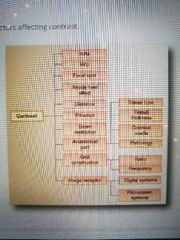![]()
![]()
![]()
Use LEFT and RIGHT arrow keys to navigate between flashcards;
Use UP and DOWN arrow keys to flip the card;
H to show hint;
A reads text to speech;
31 Cards in this Set
- Front
- Back
- 3rd side (hint)
|
Contrast |
Is one of two properties that comprise visibility of detail. Image ____ is the difference between adjacent IR exposure levels |
|
|
|
Visibility of detail |
Refers to the fact that the image is visible to the human eye only because sufficient contrast and IR exposure exist to permit the structural details to be perceived |
|
|
|
Dynamic range |
The concept of contrast as it is displayed on a soft copy monitor for digital images. Range of density / brightness of the display monitor light |
|
|
|
Window width |
The digital processing that produces change in the range of density / brightness, which can be used to control contrast Describes the digital processing that produces changes in the range of brightness, so it also is appropriate to use when controlling image contrast of a digital image displayed on a monitor |
|
|
|
Dynamic range / window width |
Is applied to grayscale bit depth. Sufficient differences in exposure to the receptor are necessary for the individual pixels to exhibit different exposure values |
|
|
|
Look-up table (LUT) |
When using a digital imaging system, the post-exposure processing algorithm (______) effectively establishes the dynamic range of the image |
|
|
|
Contrast |
Any change in overall IR exposure will affect.. |
|
|
|
High Contrast |
Few Shades of Grey. Short scale contrast. Short (narrow) dynamic range. Narrow window width. |
|
|
|
Low constrast |
Many shades of grey. Long scale contrast. Large (wide) dynamic range. Wide window width. |
|
|
|
High contrast |
When the differences between adjacent IR exposures that comprise contrast are great, the image is described as |
|
|
|
Low contrast |
Provides more differences in IR exposure levels even though the difference between the tissue density is less. As long as the differences remain within the visible range of IR exposure, this will provide more diagnostic information |
|
|
|
Scale of contrast |
The number of useful visible densities or Shades of Grey |
|
|
|
Short-scale contrast |
Refers to an image that demonstrates considerable or maximal differences between IR exposures and has a minimal total number of exposures |
|
|
|
Long-scale contrast |
Refers to an image that demonstrates light or minimal differences between IR exposures but has a maximal total number of exposures |
|
|
|
Physical contrast |
Is the total range of IR exposure values recorded by the image receptor. It is the maximum contrast possible and is the most accurate representation of the varying intensities present in the X-ray beam after it has passed through the subject |
|
|
|
Visible contrast |
Is the total range of IR exposure values that can be perceived by the human eye in a single image. It is a portion of the physical contrast and comprises the information from which diagnosis is made. |
|
|
|
Subject contrast |
Is the range of differences in the intensity of the X-ray beam after it has been intimidated by the subject. |
|
|
|
kVp |
Is the primary controller of subject contrast. As this increases, the greater will be the ability of the photons to penetrate the body tissues |
|
|
|
They are absorbed by the patient |
As long as kvp is adequate to penetrate the part being examined, low kvp will produce high subject contrast. When the kvp is too low most of the photons do not reach the image receptor because.. |
|
|
|
Increases |
As body part thickness increases, x-ray absorption.. |
|
|
|
Hydrogen, carbon, and calcium |
Materials with a higher atomic number, such as lead and iodine, absorb a greater percentage of X-ray beam then lower atomic number materials such as... |
|
|
|
Factors affecting contrast |
kVp, mAs, focal spot size, anode heel effect, distance, filtration, beam restriction, anatomical part, grid construction, and image receptor |

|
|
|
LUT |
When digital systems are used, image contrast is determined by the ____. Therefore, kvp does not have the impact on the final image contrast as it did with film screen |
|
|
|
Film screen systems |
With _____, as kvp increases, contrast decreases. As kvp decreases, contrast increases |
|
|
|
Fog |
Kvp also controls the amount of scatter radiation produced. Increasing kvp increases the amount of radiation ___, thereby decreasing contrast in film screen systems |
|
|
|
Increase |
Air gap techniques increase or decrease contrast? |
|
|
|
Filtration |
Effects contrast by changing the average Photon energy and decreasing beam intensity |
|
|
|
Grid and contrast |
The primary function is to improve contrast. The more scatter radiation is absorbed by the grid the better the contrast |
|
|
|
Differential attenuation |
The result of differences in the transmission of the beam as it passes through the patient resulting in Signal differences to the digital detector |
|
|
|
Grayscale |
The number of Shades of Gray in a radiographic image |
|
|
|
IR contrast |
The total amount of contrast acquired from the image receptor |
|

